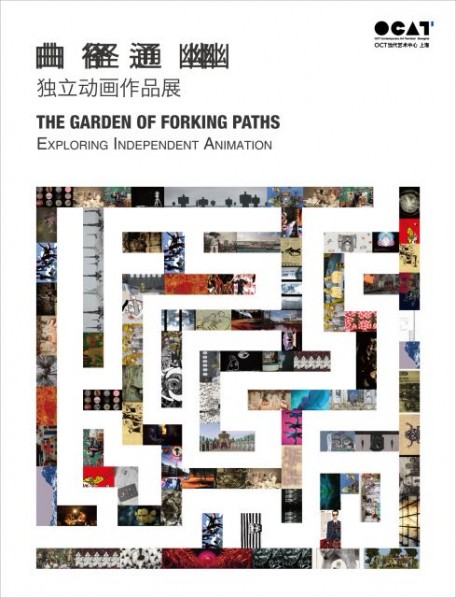
About The Garden of Forking Paths - Exploring Independent Animation
by Mariagrazia Costantino
The Chinese expression Qu Jing Tong You – literally “a winding path leads to quiet seclusion” – adequately conveys the idea of a conceptual space out of time, or better, a space suspended in a non-linear and non-eschatological time, where (and when) visions of life’s countless circumstances can be repeatedly materialized and delivered.
The inner wisdom of this proverb seems to be elaborated in Jorge Luis Borges’s novel “The Garden of Forking Paths”. Its protagonist, the spy Yu Tsun, while hopelessly trying to escape capture from his enemy runs into a revelation about the ancestor Ts’ui Ben and his unfinished literary work, planned as an inextricable labyrinth – the “garden of forking paths” itself.
Borges’s narrative strategy, as it is articulated, contains a core of simple truth: the world is just too layered to be embraced and understood at a glance, so are its phenomena. To enumerate them is impossible, therefore, instead of making lists, it is far better to look into the mechanisms of their functioning: repetitions, recurring patterns or slight shifts in perspective, and again turning points and unexpected convergences. In the hypertext Borges manages to construct, time and space become unbreakable, as in the modern (and postmodern) theoretical framework. The labyrinth is the space and the time one employs to walk through it. This is also at the core of time-based technologies and multimedia art. A careful combination of time and space generates coordinated movement, which is the premise of animation. The exploration of all the chances animated images involve and allow is the premise of independent animation.
Animation is also one of the directest ways for artists to explore their personal imagery, as well as the collectively inbuilt visual culture(s). Starting as a pure investigation into the depths of mind, with its fears, expectations, disillusions, temporary or long-term escapes, it becomes paradigmatic of a certain human condition and can be shared through its exposure: the unbridled layout of its contents and the amplification of the evils we are confronted with can relieve from the pain of being alive, and deliver from the sense of threat existence occasionally entails; or on the contrary amplify it. In a word, by liberating from the burden of unspoken words and hidden images, these works can represent/show alternatives to pre-established models and new ways of dealing not only and simply with what is real, but with what we see as real.
This exhibition is aimed at introducing to the Chinese and international public the most interesting outcomes of recent independent animation by young yet well-assessed artists, as well as the finest achievements of renowned artists making occasional or exclusive use of animation language and technology. Conceived as a maze to get lost in and reemerge, just like a labyrinth, or the path the title refers to, it can be temporarily deceitful, but it also represents the unlimited possibilities artists have to imagine, hence create, and opens up new ones for people to get closer to their visions.
To present these works, we would like to start from the idea of exploration: exploration of virtual worlds and exploration of time in the form of sequences of images on the screen. Like every other art form, it hinges upon an in-depth knowledge of history and contemporaneity, but representing an expression of the so-called “Cross Media”, it also relies on the capacity to anticipate new directions and put them in relation with each other.
Animation should be also seen as the personal adventure of artists into a terrain full of uncertainties. We are strongly persuaded that the painstaking research they carry on embodies in the best way the contradictions of a technique which through apparent fun and disengagement conveys disruptive messages.
Special thanks go to Shenzhen OCT Loft for allowing us to take a selection of works from the first Shenzhen Biennale of Independent Animation, held at OCT Loft from 22 December 2012 to 22 March 2013.
OCAT Shanghai has added to the number – comprising AES + F, Cao Fei, Chen Shaoxiong, Federico Solmi, Sun Xun, Zhou Xiaohu – other fundamental artists who have worked with and on animation: among them Gu Dexin, Feng Mengbo, William Kentridge (who has regenerated, even revolutionized the language of independent animation), Lu Yang, Nathalie Djurberg and Hans Berg (whose clay motions are exhibited in China for the first time), and Riccardo Arena, specifically dealing with the city of Shanghai. The works of all these artists will be placed within a conceptual frame in which the city of Shanghai is a crucial crossroad of cultural experiences and a platform for international dialogue.
A century ago or so, the barges that sailed down the Suzhou river, flowing just outside the exhibition halls, carried all sorts of goods to a warehouse where today priceless fantasies are collected and shared.
About the exhibition
Date: May 3, 2013 - Jul 28, 2013
Opening: May 3, 2013, 17:00, Friday
Venue: OCT Contemporary Art Terminal Shanghai
Curator: Mariagrazia Costantino, Wang Chunchen
Organizer: OCT Contemporary Art Terminal Shanghai (Shanghai, China)
Courtesy of OCT Contemporary Art Terminal Shanghai, for further information please visit www.ocat.org.cn.




























